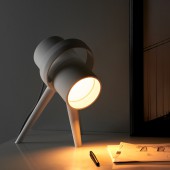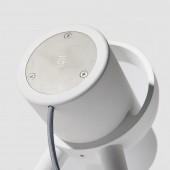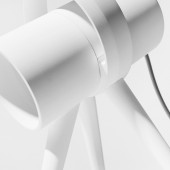
| THE AWARD |
| CATEGORIES |
| REGISTRATION |
| SUBMIT YOUR WORK |
| ENTRY INSTRUCTIONS |
| TERMS & CONDITIONS |
| PUBLICATIONS |
| DATES & FEES |
| METHODOLOGY |
| CONTACT |
| WINNERS |
| PRESS ROOM |
| GET INVOLVED |
| DESIGN PRIZE |
| DESIGN STORE |
| THE AWARD | JURY | CATEGORIES | REGISTRATION | PRESS | WINNERS | PUBLICATIONS | ENTRY INSTRUCTIONS |
Pluto Task Lamp by Heitor Lobo Campos |
Home > Winners > Design #94488 >Interview |
 |
|
FS: What is the main principle, idea and inspiration behind your design?
HL: With Pluto I wanted to design task light that could have a dynamic form while still being manufactured with FDM 3d printing. My main inspiration for its silhouette were telescopes, specially due to their interesting but stable forms.
FS: What has been your main focus in designing this work? Especially what did you want to achieve?
HL: I wanted to explore the negative space in its form, to express more "character" in its design. The handle that orbits the main light shaft is one of the key features in completing its zestful outline.
FS: What are your future plans for this award winning design?
HL: For the near future it will still be sold and manufactured by Gantri, with their innovative digital manufacturing for designer lighting.
FS: How long did it take you to design this particular concept?
HL: From initial sketches to final prototyping, it was designed for a good part of one year.
FS: Why did you design this particular concept? Was this design commissioned or did you decide to pursuit an inspiration?
HL: I decided to pursue it myself, I had many different ideas for task lights in mind, so I wanted to put them to the test. As it's clear now, Pluto was the most unique and interesting of the bunch.
FS: Is your design being produced or used by another company, or do you plan to sell or lease the production rights or do you intent to produce your work yourself?
HL: It's being manufactured and sold by Gantri, a San Francisco startup focused on eco-friendly, digital manufacturing for designer lighting.
FS: What made you design this particular type of work?
HL: In the end of the day, interest, really. I had designed a lamp for the same company (Gantri) before. I enjoyed it a lot, very much so that I wanted to see how I could create a task light, as opposed to a wider area light.
FS: Where there any other designs and/or designers that helped the influence the design of your work?
HL: I have many that influenced my work in general, mainly the Eames couple. But I would't be able to pinpoint a specific designer's influence on my ideas for Pluto.
FS: Who is the target customer for his design?
HL: I think Pluto is perfect for writers, illustrators or anyone who is particular about where-and-how their light source meets their working surface.
FS: What sets this design apart from other similar or resembling concepts?
HL: Pluto keeps the focus firmly on style. Its compact, aerodynamic cylinder is orbited by an elegant handle perched over an angled tripod base, making it easier to position with precision.
FS: How did you come up with the name for this design? What does it mean?
HL: Pluto is named after the famous dwarf planet, since the design's form has a handle that "orbits" its main body and was inspired by telescopes.
FS: Which design tools did you use when you were working on this project?
HL: Mostly sketching (digital and pen) for the first development of the idea, followed by CAD modeling software to further bring it to life.
FS: What is the most unique aspect of your design?
HL: Its elegant handle that orbits it's main cylinder, it makes it easier to position the light target with precision.
FS: Who did you collaborate with for this design? Did you work with people with technical / specialized skills?
HL: I worked with the engineering team at Gantri, they helped refine details, how to effectively manufacture it for 3d printing and advanced prototyping.
FS: What is the role of technology in this particular design?
HL: Pluto was designed to be manufactured with FDM on-demand 3d printing, besides using more sustainable materials, it was made to be printed in five different parts in order to curb the use of supports and other wasted materials.
FS: What are some of the challenges you faced during the design/realization of your concept?
HL: There was a long process of back-and-forth on refining the final form and its angles, specially between the tripod legs and main body, that would allow it to be printed more easily and in fewer parts.
FS: How did you decide to submit your design to an international design competition?
HL: Pluto was the second light I designed for Gantri, so I had more experience when it launched, in general I saw that I received a lot more compliments from designers for it over my first lamp, and that gave me the confidence to submit it to a competition.
FS: Thank you for providing us with this opportunity to interview you.
A' Design Award and Competitions grants rights to press members and bloggers to use parts of this interview. This interview is provided as it is; DesignPRWire and A' Design Award and Competitions cannot be held responsible for the answers given by participating designers.
| SOCIAL |
| + Add to Likes / Favorites | Send to My Email | Comment | View Press-Release | Translations |





